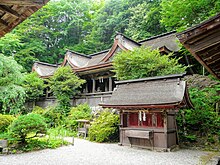Yoshino Mikumari Shrine (吉野水分神社, Yoshino Mikumari-jinja) is a Shinto shrine located on Mount Yoshino in Yoshino district, Nara, Japan.[1] It is closely associated with Emperor Go-Daigo.
| Yoshino Mikumari-jinja 吉野水分神社 | |
|---|---|
 The honden, or main hall, is an Important Cultural Property | |
| Religion | |
| Affiliation | Shinto |
| Deity | Ame-no-mikumari-no-kami (main deity) |
| Location | |
| Location | 1612 Yoshino-yama, Yoshino-chō Yoshino-gun, Nara-ken |
| Geographic coordinates | 34°21′14″N 135°52′23″E / 34.35389°N 135.87306°E |
| Architecture | |
| Date established | Unknown, possibly 806 |


The Shrine is dedicated to mikumari, a female Shinto kami associated with water, fertility and safe birth. Yoshino Mikumari Shrine is one of four important mikumari shrines in the former province Yamato. The shrine also houses six kami that are more or less related to mikumari (Takami-musubi-no-kami, Sukuna-hiko-no-kami, Mikogami, Ama-tsu-hiko-hi-no-ninigi-no-mikoto, Tamayori-hime-no-mikoto, and Yorozu-hata-toyo-akitsushi-hime-no-mikoto). A wooden statue of the deity Tamayori hime is registered as a National Treasure of Japan.
The present-day buildings go back to 1605, when Toyotomi Hideyori rebuilt the shrine, as his father Toyotomi Hideyoshi once had prayed here for a son and successor. The main hall (honden), an Important Cultural Property,is an unusual structure 9 ken long and 2 ken wide. Built in the nagare-zukuri style, it has however an independent 1x1 ken unit in the kasuga-zukuri style at the center. The three resulting edifices all lie under the same bark roof, which has three dormer gables.[2]
In 2004, it was designated as part of a UNESCO World Heritage Site under the name Sacred Sites and Pilgrimage Routes in the Kii Mountain Range.
See also
edit- List of Shinto shrines
- Twenty-Two Shrines
- List of National Treasures of Japan (sculptures)
- Modern system of ranked Shinto Shrines
Notes
edit- ^ Richard, Ponsonby-Fane. (1964) Visiting Famous Shrines in Japan, pp. 300-307.
- ^ "Yoshino Mikumari Jinja". Cultural Properties Database (in Japanese). Agency for Cultural Affairs. Retrieved 1 January 2010.
References
edit- Ponsonby-Fane, Richard Arthur Brabazon. (1962). Studies in Shinto and Shrines. Kyoto: Ponsonby Memorial Society. OCLC 399449
- ____________. (1959). The Imperial House of Japan. Kyoto: Ponsonby Memorial Society. OCLC 194887
- ____________. (1964). Visiting Famous Shrines in Japan. Kyoto: Ponsonby-Fane Memorial Society. OCLC 1030156
